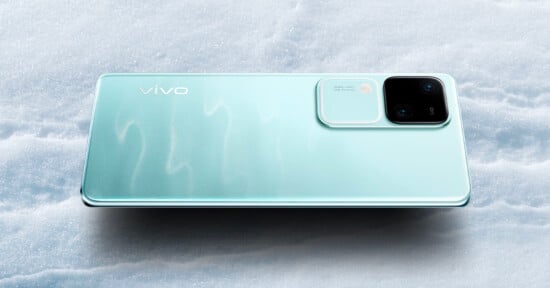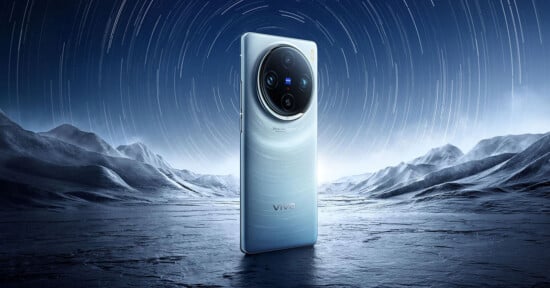Vivo V50 Review: Marvelous Mid-Range Photo Prowess

There’s something unassuming about the Vivo V50 when first looking at it, yet its camera performance should be a wake-up call to others. The company still sees this phone as unique for its Aura Light in portrait photos but the more significant improvements come from everywhere else.
The V50 isn’t without its drawbacks and compromises. As a mid-ranger in the $400-$500 range, it leaves some things out to keep the price down. It’s just that the more affordable cost and omissions are perhaps easier to accept when seeing how dependable the camera is. If Vivo could make it more widely available, it would help the brand serve notice.
Vivo V50 Review: Design and Build
I’ll start with what’s missing or pared down. There’s no telephoto camera at all, significantly limiting your ability to get closer to a subject. The Snapdragon 7 Gen 3 chipset is outdated at this point for flagships, and Vivo missed a chance to upgrade since the previous V40 used the same chipset. While there’s glass on both the front and back, the rest of the device is heavier on plastic as a cost-cutting measure.
Vivo wisely chooses to go with a matte finish in the back to ward off fingerprints. It also better serves the interesting color choices: satin black, starry blue, mist purple, and ancora red. Undoubtedly, the latter three are colorful by industry standards, and Vivo includes a basic silicone case to add some protection while letting the color still come through.
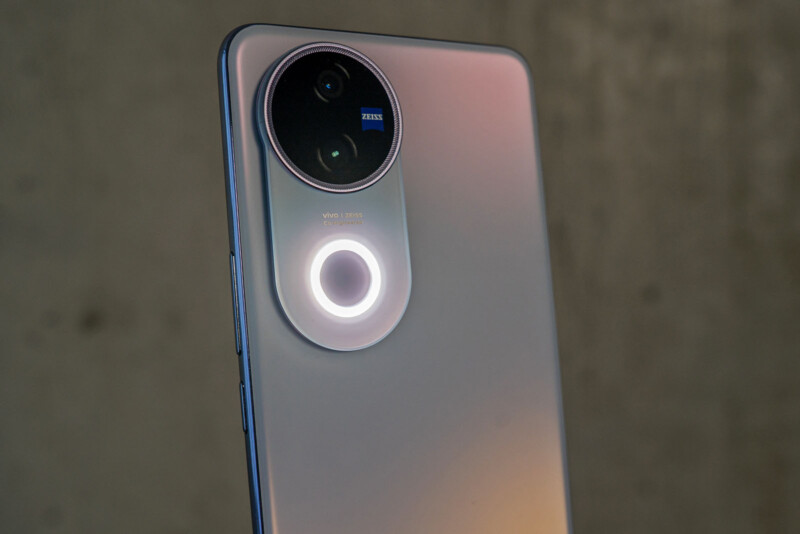
The Aura Light is now a standard part of V-series phones, and the illuminated ring returns here, sitting below the lenses. As before, you can manually shift color temperature via a slider in the camera app or let the ambient sensor do it for you automatically. It’s slightly more diffused than the V30 or V40 series models, making it better suited for more than just capturing portraits.
Vivo has also taken the right steps to continue flattening its screens, as evidenced by how the 6.77-inch AMOLED screen (2,392 x 1,080) feels in hand. Granted, it does have a slight curve along the edges, but you notice it more when using the phone without a case. Vivo’s Diamond Shield glass protects the front, though I recommend getting a tougher case if you’re worried about durability. Still, IP68/69 protection is impressive for a mid-ranger, given flagships have only just started implementing that level of water resistance.
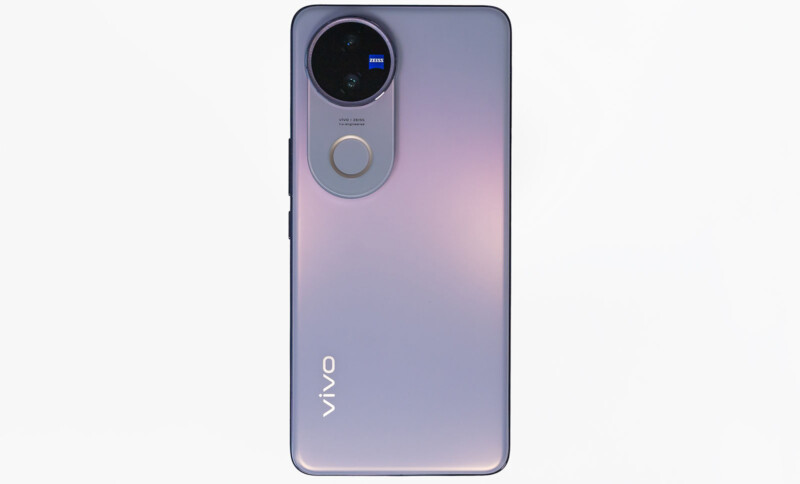
There is no wireless charging, which isn’t a massive surprise at this price. Still would’ve been nice to see since Google routinely includes it in its Pixel A series. On the other hand, Vivo packs a big 6,000mAh battery inside, outpacing most current flagships. While my review unit had 12 GB of RAM and 512 GB storage, other variants start with 8 GB and 128 GB, going up to 12 GB and 256 GB. Vivo’s Extended RAM is also standard, letting you double the RAM by pulling virtual memory from the phone’s empty storage.
One big gripe I have about the V50 is its lack of eSIM support — a significant issue for frequent travelers. It’s not clear if that might change with a newer variant should Vivo release one when it eventually expands availability (as it claims to) but for now, you need to use the dual-SIM card slot.
Vivo V50 Review: Camera Features
Vivo’s partnership with Zeiss extended to the V-series going back to the V30 Pro, so it’s more about shoring up things by trickling them down from the flagship X-series. There is still no Zeiss T* Coating for the camera module, but Vivo says Zeiss helped co-engineer the rear camera array.

The 50-megapixel main camera (23mm equivalent) has the same Type 1/1.55 Sony IMX921 image sensor used in the previous Vivo V40. The f/1.9 aperture remains the same, only this time the lens includes an integrated mini gimbal for “DSLR-level” optical image stabilization.
The 50-megapixel ultra-wide (15mm equivalent, f/2) sticks with the Samsung Isocell JN1, a sensor Vivo keeps recycling in its V-series going back to the V30 Pro. In fact, it does the same with the 50-megapixel front camera, using the JN1 going back to the V29.
That leaves most changes to the software, building off the improvements that have come from previous models. It’s just that Vivo releases V-series phones so soon after one another that changes don’t always feel as substantial, and that’s certainly part of the feeling here, too.
Vivo V50 Review: Software Features
The image processing pipeline is the most integral part that’s trickled down from the X-series. The V50 processes images in much the same way, leading to composition and results that can sometimes shock others. Zeiss’ Natural photographic style is back as an option next to the Vivid and Texture to help you determine what kind of look you want.

Vivo’s focus on portrait photography shows how Portrait mode lets you shoot at 23mm, 35mm, and 50mm, the latter two being crop factors, all of which are the focal distances Vivo feels get the most out of the Aura Light. It even includes new lighting styles — Rembrandt Lighting and Butterfly Lighting — to create a three-dimensional effect or emphasize glamour through one’s face. These are on top of the 11 existing styles, and you also retain the option to control virtual bokeh by using any of Zeiss’ seven choices.
The Aura Light is far more versatile than Vivo lets on because it focuses on its use relative to human subjects. It proves to be a nice fill light for capturing products or objects and is one of the best fill lights I’ve seen for helping others take photos in low-light conditions with other phones. The warm and cool temperatures (plus brightness levels) add to the versatility, helping capture a mood to an image that isn’t possible with built-in lighting on other mid-range phones.
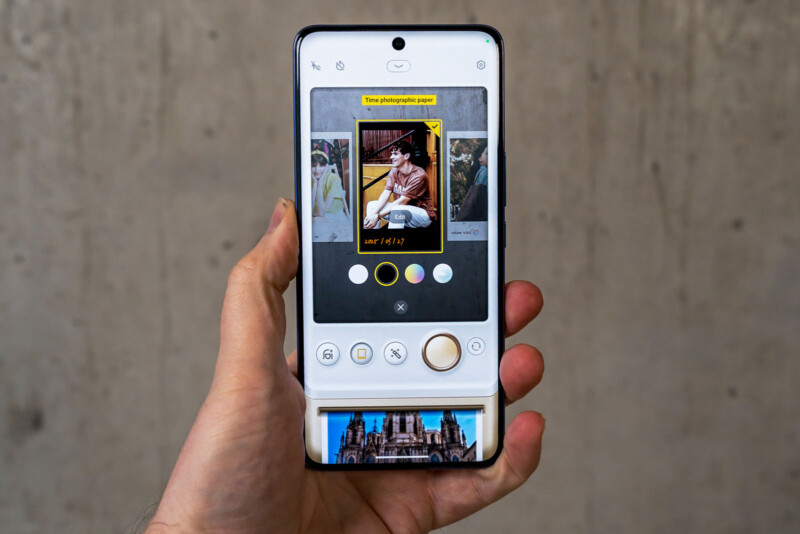
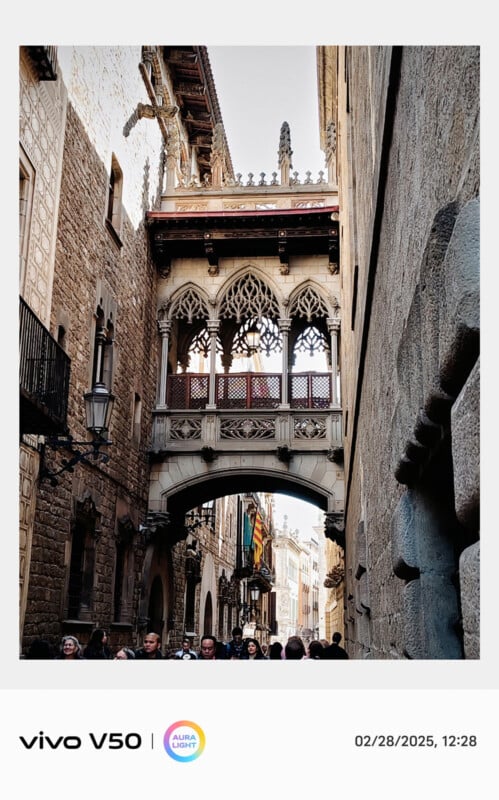
Vivo tries to illustrate that point further through Film Camera mode, a separate camera interface you can access by swiping down from the top of the camera app. This mode emulates Polaroids but also uses processing to emulate old film stock to give photos a different look. It’s mostly gimmicky, and not a strong pillar for the overall camera system, though I can see how some might like the look of these images when sharing them with others.
Vivo V50 Review: Image Quality
Main Camera
The main camera tells two concurrent stories after you use it for a while. First, the imaging pipeline is outstanding for a phone of this caliber. Simply put, dynamic range is seriously competitive with most flagships I test these days, which is a real testament to what Vivo and Zeiss have pulled off here. Like Vivo’s flagships, the V50 handles exposed light sources and contrast variances in impressive ways.


That also extends to low-light conditions, where the V50 is capable of holding down nice compositions, particularly when there’s decent ambient light to work with. It dampens exposed bulbs, including neon lights, in ways that may appear a bit unrealistic, though a quick edit in the Albums app can quickly fix that.
Not surprisingly, when you start to pixel-peep, you see the gap between the V50 and Vivo’s X-series, revealing softer pixels hiding some of the detail in an image. That’s not shocking, considering the phone’s mid-range attributes, but those shortcomings are far less noticeable when viewing images from phone to phone. I stunned some non-Vivo users by showing them what I captured straight from the camera.
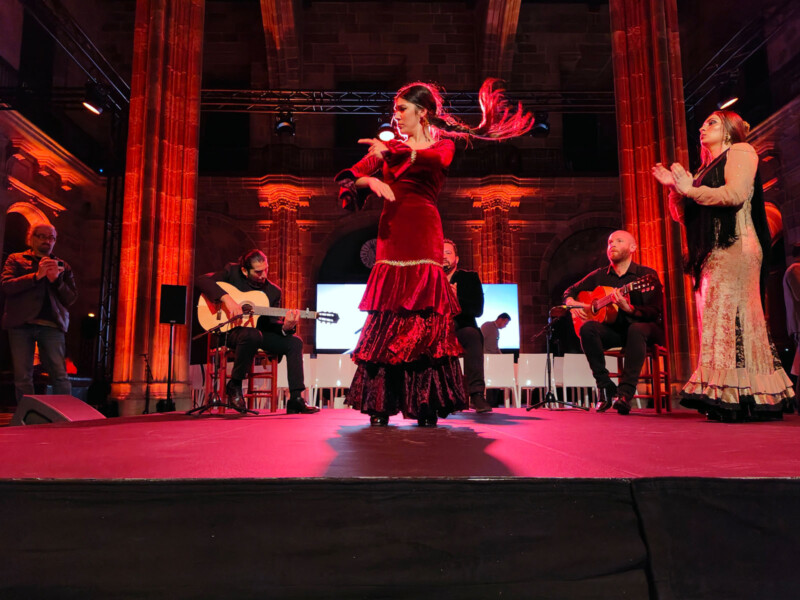

That leads to the second story, which is Snapshot mode. Despite having inferior lenses and sensors compared to the Vivo X200 Pro, the V50’s action photography capabilities are noteworthy. It’s not common to see a mid-range phone at this price be able to do that, especially when North American users have iPhone, Galaxy, and Pixel devices as frames of reference, all having largely ignored action shots. The action shots I got here wouldn’t happen with any of those three unless I set something up in Pro or manual mode.
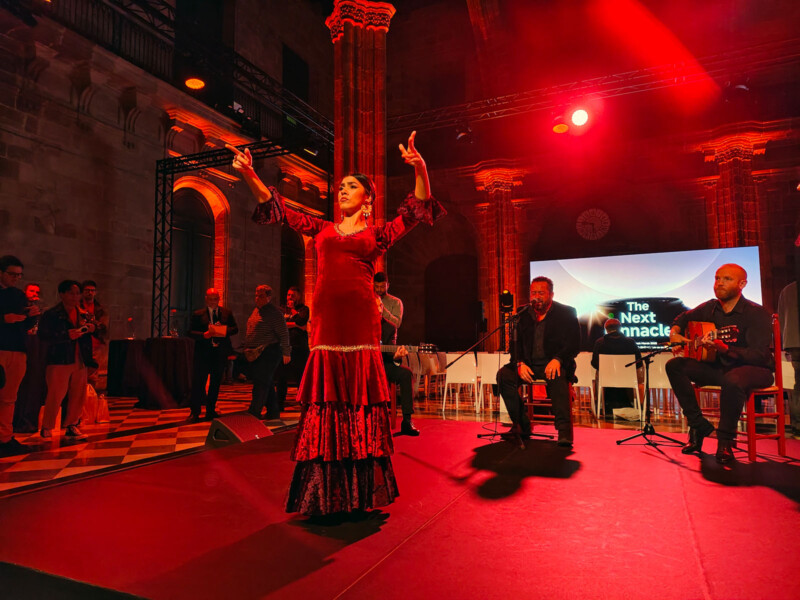
Equally impressive is how Vivo manages this in varying lighting conditions. I got excellent photos of the flamenco dancers in spite of the heavy red and dim lighting. It’s not perfect, mind you, as both speed and timing are determining factors, but the mere fact output like this is routine is a big win for the V50.
Digital Zoom and Ultra-Wide
The lack of a telephoto lens leaves you with limited focal options, though the main camera’s crop factors aren’t too bad. They get progressively worse the further you zoom in, but the 2x zoom (46mm) isn’t a bad place to start. Things fall apart faster in low-light conditions, as the software processing kicks into a higher gear to ward off any imperfections.
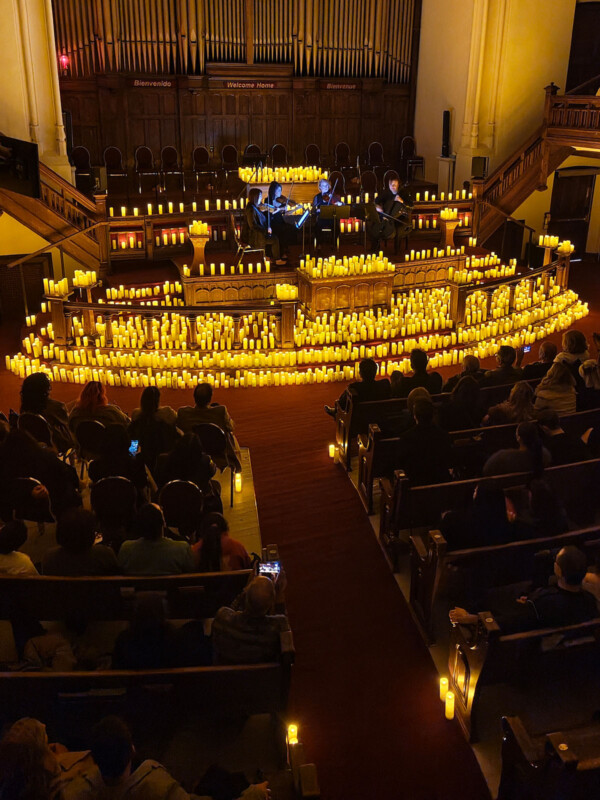
The ultra-wide has less of a wow factor since it’s so familiar. Its 119-degree field of view is nice because it doesn’t deliver detail in the middle at the expense of the edges. Plus, it has autofocus (unlike some other ultra-wide cameras) to help better compose the kind of photo you want. It can also double as a macro shooter along with the main camera to add something else to its toolkit.
Pro and High-Resolution
Unsurprisingly, you can’t shoot in RAW at full resolution in Pro mode, so you must take pixel-binned 12.5-megapixel images. Your only alternative is to use High-Resolution mode to capture full-res JPEGs, which I did more often in ideal lighting conditions, choosing Pro mode in RAW when lighting wasn’t as optimal.

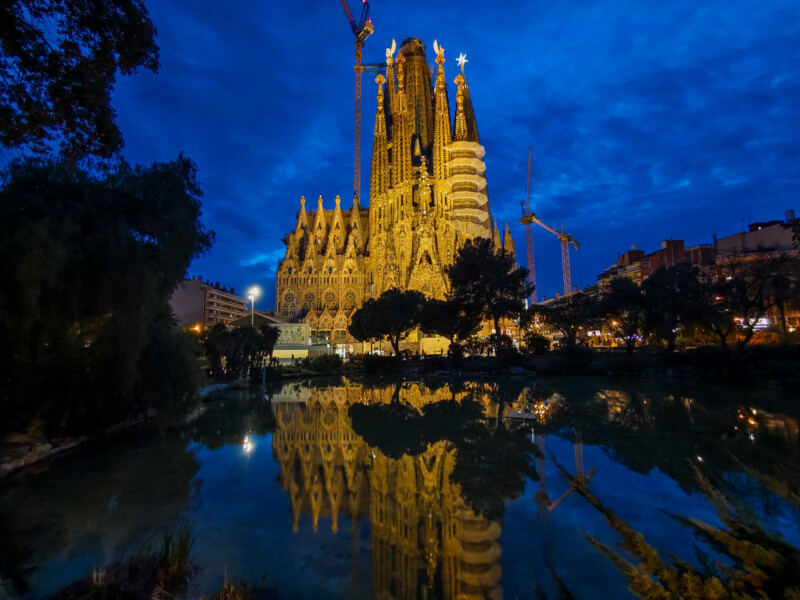
Still, a well-lit subject in low light can turn out nicely as a full-res JPEG. For closer subjects, the Aura Light can be an interesting tool to use to add some light, even if you can’t control the angle it’s coming from. I experimented with a piece of paper and tissue as an additional diffuser with mixed results.
Vivo V50 Review: Video Features
Vivo has been quietly improving video recording on its V-series devices, and the V50 continues the trend, primarily for the main camera. The company suggests it did more for the 50-megapixel selfie camera but I would argue the main rear one is better to use for vlogging because it just handles fluctuations in light and color more effectively. Plus, you also have the Aura Light to work with.
You can record in 4K at 30fps in all lenses, including the front one. Use the Zeiss Bokeh style, and you can also record at 1080p and 24fp for a more cinematic look. That includes a batch of movie LUTs to instill a specific style or look to your clips should you want to go that route. Micro Movie returns as a social media-focused mode designed for shorter snippets in portrait orientation. So does Dual View, where you can record from two of the cameras at the same time.
Are There Alternatives?
The V50 is impressive in its own right, but mid-range phones from others aren’t devoid of good performance. From the same region, the Poco X7 Pro and Xiaomi 14T are interesting options that can produce excellent photos, even if they don’t match Vivo’s dynamic range. The Nothing Phone 3a is more widely available at the same price and offers a telephoto lens, though it won’t match the action photography output seen in the V50.
The upcoming Google Pixel 9a could be an enjoyable alternative, given the price relative to the ease of the camera. It’s not clear how good the Samsung Galaxy A36 will be as that brand’s mid-range option. The OnePlus 13R costs a bit more but is also a worthy selection since it improves a fair bit from its predecessor. As for Apple, the iPhone 16e only gives you one rear lens, yet charges you $200 more for owning one.
Should You Buy the Vivo V50?
Yes, if it’s within your budget — but more importantly, if you can get your hands on one. The Vivo V50 rolled out first to markets in Asia and the Middle East, with others, like Africa, Europe, and the U.K. reportedly coming sometime this year. That move might open the gates further to grab one from an online retailer.

